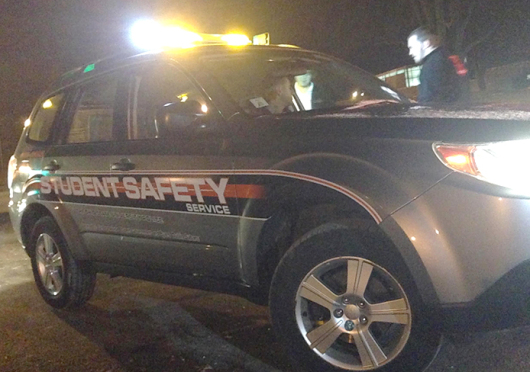
While most students are familiar with Student Safety Service for escort services, the program worked over 3,000 hours in 2014 at events such as move-in day, Buck-i-Frenzy and commencement. Credit: Eric Weitz / Lantern reporter
Student Safety Service vehicles are often seen shuttling students around campus late at night, but the program does more than chauffeur students from the Union to residence halls on chilly evenings.
Student Safety Service recently wrapped up a year of crime deterrent practices, which introduced a bus security program and an off-campus high-visibility patrol initative.
In 2014, Student Safety Service provided escort services to 20,496 people. However, program coordinator Sean Bolender said the program provided a variety of services to students last year.
He said Student Safety Service worked 3,014 hours, or more than 125 days, outside of escort services in 2014. It worked at sporting events, concerts and other university events, including move-in day, Buck-i-Frenzy and commencement.
Student Safety Service senior manager and recent Ohio State graduate Neal Wilson said the duties of officers changed from event to event based on the particular security needs at the time.
“One of the nice things about Student Safety is that the longer you work here, and the different events you work, the more you realize it is a very fluid job,” he said. “Really, we do whatever is requested of us.”
Wilson said special event duties included a variety of responsibilities, such as ensuring that attendees arrived at and entered the venues safely and assisting those with disabilities or medical conditions with escort services.
Bolender said last year, officers were present at OSU football and basketball games, the PGA Golf Tour and the Special Olympics. Officers were also asked to assist with security at Miley Cyrus, Arcade Fire, Willie Nelson and Michael Bublé concerts.
During spring 2013, Student Safety Service also teamed up with the Department of Transportation and Traffic Management to provide security on late night East Residential buses. After a trial period that semester, the program was implemented in the fall.
Wilson said student officers remain present on the buses on Friday and Saturday nights to assist the driver in making sure riders are following policies during the extended hours.
“We are a visual deterrent for people who want to get too rowdy on the buses or cause problems for the driver,” he said. “There have been more than a couple cases where we have actually had an officer respond to a first-aid situation that they witnessed either directly on the bus or nearby. It’s not only helping the drivers in situations like that, it’s helping the broader community as well.”
Bolender echoed that concept, recalling an instance when a student officer left the bus to render first aid to someone at a stop.
Last year, Student Safety Service also conducted more than 4,000 checks of buildings and parking lots on campus, Bolender said.
“A common misconception is that when people see our staff inside a building, we’re looking to see if a student is causing trouble,” he stated in an earlier email. “Our real purpose is to make sure people who don’t belong in the building, people who may be there to conduct a crime, get reported to the police.”
Bolender said student officers receive first aid and security training that allows them to conduct these random checks and detect possible concerns that an ordinary person might overlook.
“They are there to try to prevent crime from occurring in the first place,” he said. “We are hoping that if somebody was thinking about breaking into a car, they would see our vehicle moving through the parking lot and think otherwise.”
Bolender said Student Safety Service foot and bike patrols are assigned to conduct these random checks, but student officers assigned to escort services also check buildings and lots if they have no calls for escorts.
“Rather than the vehicle just sitting and idling, which would be a waste of university resources, we encourage them to go out and do those types of checks to continue to build up the visual presence we have on campus for security,” Bolender said.
During Fall Semester 2014, Student Safety Service also launched a new pilot program called Operation Safeguard, which places high-visibility patrols in off-campus neighborhoods east of High Street.
“This is a fantastic new initiative that Administration and Planning rolled out, where they have students providing high-visibility patrols east of High Street,” Bolender said of Operation Safeguard. “We are trying to make the area saturated with security presence so that anybody who would seek to do a crime would think otherwise. It’s more about deterrence than anything.”
As part of the program, Student Safety Service also occasionally stations its mobile command center near the south side of the Ohio Union, providing students with hot beverages and the opportunity to talk with student officers about safety.
Bolender added that Student Safety Service also provided training for student groups and dining hall managers in CPR, first aid, and automated external defibrillator use upon request.
Student Safety Service employs about 35 students who typically work between 21 and 28 hours each week.
Bolender said all student officers are trained in every aspect of the program.
“The idea is that at any point, if there is a gap, we can take any person within our program and put them in to do the mission for whatever that program is,” he said.


